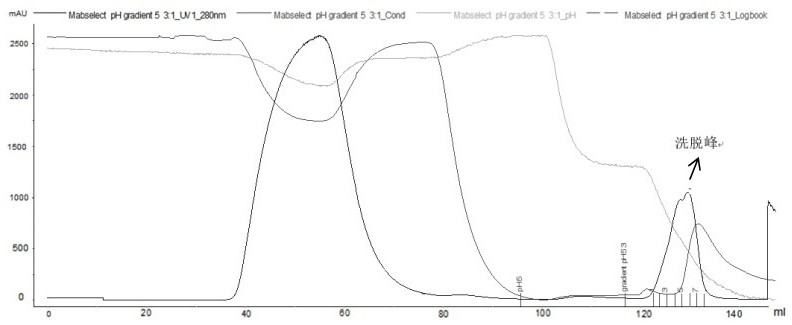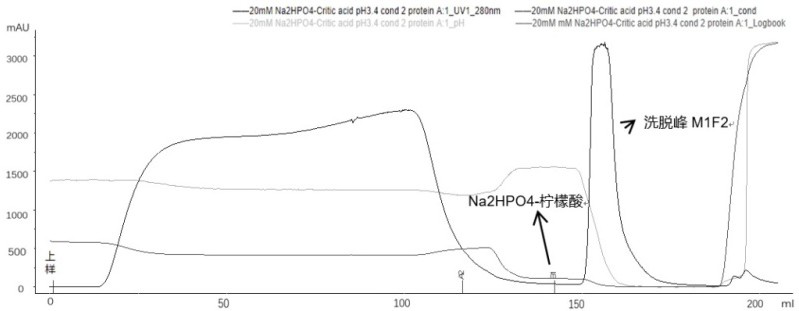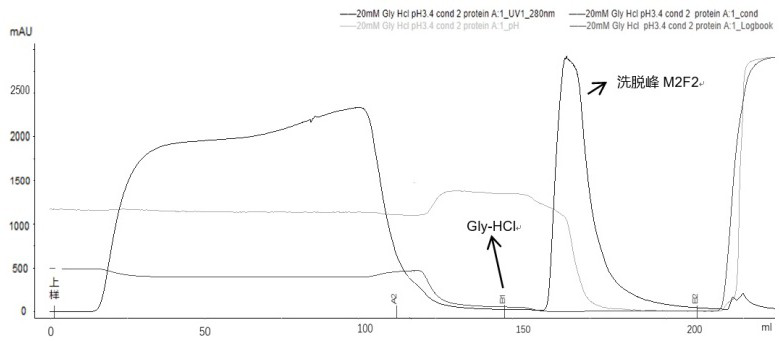A method for removing recombinantly expressed antibody aggregates and degradation products
An antibody and monoclonal antibody technology, applied in the preparation methods of peptides, chemical instruments and methods, anti-animal/human immunoglobulins, etc., can solve the problem of difficult to remove antibody aggregates and degraded fragments, increase antibody protein retention time, etc. question
- Summary
- Abstract
- Description
- Claims
- Application Information
AI Technical Summary
Problems solved by technology
Method used
Image
Examples
Embodiment 1
[0079] Example 1: Protein sequence of recombinant human anti-TNF-α monoclonal antibody.
[0080] A human antibody for the treatment of TNF-α-related diseases is a recombinant human anti-TNF-α monoclonal antibody, which is expressed in CHO cells by means of genetic engineering, and purified by a series of standard chromatography steps. The adalimumab sequence specifically used in this example has the heavy chain variable region described in SEQ ID NO:1; and has the light chain variable region described in SEQ ID NO:2. Its molecular weight is about 148kDa and consists of 2 IgG1 heavy chains and 2 kappa light chains. Each heavy chain contains 451 amino acids with a molecular weight of about 49kDa, and its sequence is shown in SEQ ID NO:5; each light chain contains 214 amino acids with a molecular weight of about 24kDa, and its sequence is shown in SEQ ID NO:6.
Embodiment 2
[0081] Example 2: Recombinant expression and purification of recombinant human adalimumab.
[0082] Referring to the method of Wood et al., J Immunol. 145:3011 (1990), etc., the monoclonal antibody anti-TNF-α antibody that specifically binds to TNF-α was expressed in CHO cells. The expression vector containing the antibody gene was constructed by conventional molecular biology methods (Molecular Cloning), and a derived cell line of CHO-k1 cell (ATCCCCL61) was used as the host cell for expression. The construction process of high-yielding stable cell lines is briefly described as follows: host cells are grown in suspension in CD-CHO medium (Gibco, CA), centrifuged host cells in logarithmic growth phase, resuspended in fresh CD-CHO medium, and counted. and adjust the cell density to 1.43 × 10 7 Cells / ml, take 600ul of the above cell suspension and add it to the electric shock cup, then add 40ug of the linearized plasmid, (use a pipette to mix the cells and the plasmid evenly. U...
Embodiment 3
[0083] Example 3: Effects of recombinant adalimumab general affinity chromatography pre-washing conditions on yield and monomer purity.
[0084] By adding pre-wash steps in affinity chromatography, mainly adding different pre-wash additives, the effect of pre-wash conditions on the removal of aggregates was investigated. If prewash conditions are not suitable, focus on optimization studies of the elution step.
[0085] Affinity chromatography (different prewash):
[0086] Filler: GE Mabselect 5ml, column: Borgron BXP10mm / 20cm, column height: 6.4cm;
[0087] Buffer:
[0088] Equilibration buffer Buffer A1 (20mM PB+ 0.15M NaCl, pH 7.0);
[0089] Re-equilibration buffer Buffer A2 (20mM PB, pH 7.0);
[0090] 3 kinds of pre-elution buffer B1-1 (20mM PB + 1M urea, pH 7.0);
[0091] Buffer B1-2 (0.2 M Arg-HCl + 1 M NaCl, pH 7.0);
[0092]Buffer B1-3 (10 mM EDTA + 1 M NaCl, pH 7.0);
[0093] Eluent Buffer B2 (20mM citric acid-Na 2 HPO 4 , pH 3.4).
[0094] experiment procedu...
PUM
| Property | Measurement | Unit |
|---|---|---|
| molecular weight | aaaaa | aaaaa |
| molecular weight | aaaaa | aaaaa |
| molecular weight | aaaaa | aaaaa |
Abstract
Description
Claims
Application Information
 Login to View More
Login to View More - R&D
- Intellectual Property
- Life Sciences
- Materials
- Tech Scout
- Unparalleled Data Quality
- Higher Quality Content
- 60% Fewer Hallucinations
Browse by: Latest US Patents, China's latest patents, Technical Efficacy Thesaurus, Application Domain, Technology Topic, Popular Technical Reports.
© 2025 PatSnap. All rights reserved.Legal|Privacy policy|Modern Slavery Act Transparency Statement|Sitemap|About US| Contact US: help@patsnap.com



